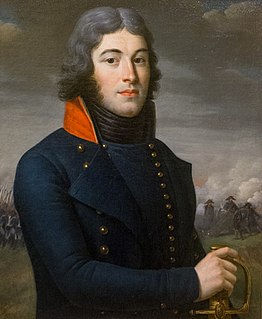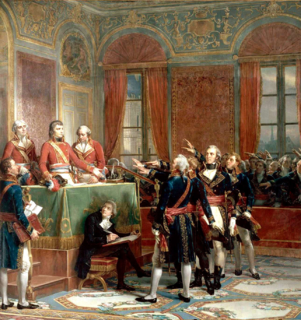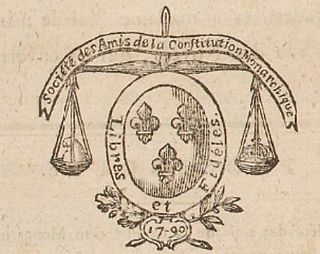Electoral results
| Council of Five Hundred | |||||
| Election year | No. of overall votes | % of overall vote | No. of overall seats won | +/– | Leader |
|---|---|---|---|---|---|
| 1795 | Unknown (2nd) | 36 | 160 / 500 | – | |
| 1797 | Unknown (1st) | 59 | 387 / 657 | ||
Clichy Club Club de Clichy | |
|---|---|
| Leader | |
| Founded | 28 July 1794 |
| Banned | 5 September 1797 |
| Preceded by | Feuillant Club |
| Ideology | Anti-abolitionism [ citation needed ] Conservatism Laissez-faire Monarchism |
| Political position | Right-wing |
| Colours | Blue |
Means of revenues were several aristocrats such as Charles Maurice de Talleryrand, Germaine de Staël and Prince of Condé | |
The Clichy Club (French : Club de Clichy) was a political group active during the French Revolution from 1794 to 1797.
During the French Revolution, the Clichy Club formed in 1794 following the fall of Maximilien Robespierre, 9 Thermidor an II (27 July 1794). The political club that came to be called the Clichyens met in rooms in the rue de Clichy, which led west towards the fashionable Parisian suburb of Clichy. The club was initially constituted around the dismissed deputés of the National Convention, most of whom had been imprisoned during the Reign of Terror. Under the French Directorate, they began to play an increasingly important role on the political right, embracing moderatism republicans and monarchists, namely those who still believed that in a constitutional monarchy based in part on the British model lay the best future for France. The main Clichyens were François Antoine de Boissy d'Anglas, Jean-Charles Pichegru and Camille Jordan. [1] Among other members were Guillaume-Mathieu Dumas, Pierre Paul Royer-Collard and General Amédée Willot. With the closure of the Jacobin Club in November 1794, the danger from the political left appeared to subside and moderates drifted away from the Clichy Club, which was dormant for several years.
Under the Directorate, the salons of Paris began cautiously to reconvene under the guidance of women whose fortunes had not been ruined during the Revolution's first decade—the private sphere became politicized "one of the few sanctuaries of free exchange" observes the historian of the salons as a political force as the public sphere was not free. [2] Within the span of political opinion, those members of the Clichy Club who figured among the Monarchiens signalled their party loyalties in the long black waistcoats they wore. [3] Madame de Staël attempted in her salon mixte to bridge the social and political differences between the Monarchiens of the Clichy Club and factions who were more securely associated with the new regime, such as those who congregated with Benjamin Constant at the Hôtel de Salm or in Charles Maurice de Talleyrand-Périgord's circle.
In a rearguard reaction to preserve the rapidly dissolving powers of the Directorate in the face of public opinion, after 205 of 216 conventionnels who ran for re-election in 1797 were rejected by the limited group of enfranchised voters (though two of the Clichyens were seated), [4] the extremists among the Clichy Club were intent on turning out the Directors and repealing Revolutionary legislation, especially that directed against the returned émigrés and the Catholic Church.
The Clichy Club seemed to be in a position to dominate the Council of Five Hundred through the newly elected deputies. Divisions among the group pitted about 80 intransigent partisans for the return of monarchy, headed by Jean-Louis Gibert des Molières, against moderates around Mathieu Dumas, who avoided confrontations with the five-man Directorate. The apex of the Clichyens' influence was in the election to the Directorate of François-Marie, marquis de Barthélemy.
Napoleon Bonaparte's reaction was a proclamation to the army denouncing the Clichyens and matters rapidly evolved in the coup d'état of 18 Fructidor. On 3 September 1797, a royalist conspiracy was announced and the following morning Pichegru, still in correspondence with the Prince de Condé, [5] was among those arrested. However, few others among the Clichyens were in such treasonable relations with the royalist pretender and his advisors. [6] On the fifth, he was among those ordered for deportation to Guyane and the new party rapidly consolidated its power. Among its first actions was to close and ban the Clichy Club, though it hesitated to treat other more private salons—though kept under close police surveillance—as political associations, which the Directorate had previously banned as "private associations occupying themselves with political questions". [7]
In the history of slavery, the Clichyens's nucleus of French colonial planters coordinated a common voice against abolition as detrimental to the French colonies. Public statements of the Clichy Club generally appeared in the right-wing press, L'Éclair, Le Véridique, Le Messager du soir and Les nouvelles politiques. [8]
| Council of Five Hundred | |||||
| Election year | No. of overall votes | % of overall vote | No. of overall seats won | +/– | Leader |
|---|---|---|---|---|---|
| 1795 | Unknown (2nd) | 36 | 160 / 500 | – | |
| 1797 | Unknown (1st) | 59 | 387 / 657 | ||

The French Revolution was a period of radical political and societal change in France that began with the Estates General of 1789 and ended with the formation of the French Consulate in November 1799. Many of its ideas are considered fundamental principles of liberal democracy, while phrases like liberté, égalité, fraternité reappeared in other revolts, such as the 1917 Russian Revolution, and inspired campaigns for the abolition of slavery and universal suffrage. The values and institutions it created dominate French politics to this day.

The Directory was the governing five-member committee in the French First Republic from 2 November 1795 until 9 November 1799, when it was overthrown by Napoleon Bonaparte in the Coup of 18 Brumaire and replaced by the Consulate. Directoire is the name of the final four years of the French Revolution. Mainstream historiography also uses the term in reference to the period from the dissolution of the National Convention on 26 October 1795 to Napoleon's coup d’état.

Louis Lazare Hoche was a French soldier who served during the French Revolutionary Wars and rose to become a general of the Revolutionary Army. He won a victory over Royalist forces in Brittany. His surname is one of the names inscribed under the Arc de Triomphe, on Column 3. Richard Holmes says he was "quick-thinking, stern, and ruthless... a general of real talent whose early death was a loss to France." A famous statement by general Hoche: "Facta, non verba"

Marie Joseph Louis Adolphe Thiers was a French statesman and historian. He was the second elected President of France and first President of the French Third Republic.

Jean-Charles Pichegru was a distinguished French general of the Revolutionary Wars. Under his command, French troops overran Belgium and the Netherlands before fighting on the Rhine front. His royalist positions led to his loss of power and imprisonment in Cayenne, French Guiana during the Coup of 18 Fructidor in 1797. After escaping into exile in London and joining the staff of Alexander Korsakov, he returned to France and planned the Pichegru Conspiracy to remove Napoleon from power, which led to his arrest and death. Despite his defection, his surname is one of the names inscribed under the Arc de Triomphe, on Column 3.

The Consulate was the top-level Government of France from the fall of the Directory in the coup of 18 Brumaire on 10 November 1799 until the start of the Napoleonic Empire on 18 May 1804. By extension, the term The Consulate also refers to this period of French history.
The Thermidorian Reaction is the common term, in the historiography of the French Revolution, for the period between the ousting of Maximilien Robespierre on 9 Thermidor II, or 27 July 1794, and the inauguration of the French Directory on 2 November 1795.

Louise Marie Adélaïde Eugénie d'Orléans was a French princess, one of the twin daughters of Philippe d'Orléans, known as Philippe Égalité during the French Revolution, and Louise Marie Adélaïde de Bourbon. She was titled Mademoiselle de Chartres at birth, Mademoiselle d'Orléans at the death of her older twin sister in 1782, Mademoiselle (1783–1812), Madame Adélaïde (1830). As a member of the reigning House of Bourbon, she was a princesse du sang.

The Council of Five Hundred, or simply the Five Hundred, was the lower house of the legislature of France under the Constitution of the Year III. It existed during the period commonly known as the Directory (Directoire), from 26 October 1795 until 9 November 1799: roughly the second half of the period generally referred to as the French Revolution.

A salon is a gathering of people held by an inspiring host. During the gathering they amuse one another and increase their knowledge through conversation. These gatherings often consciously followed Horace's definition of the aims of poetry, "either to please or to educate". Salons in the tradition of the French literary and philosophical movements of the 17th and 18th centuries were carried on until as recently as the 1920s in urban settings.

Joseph, comte Souham was a French general who fought in the French Revolutionary Wars and the Napoleonic Wars. He was born at Lubersac and died at Versailles. After long service in the French Royal Army, he was elected to lead a volunteer battalion in 1792 during the French Revolution. He was promoted to general of division in September 1793 after playing a prominent role in the defense of Dunkirk. In May 1794 with his commander absent, he took temporary command of the Army of the North and defeated the Coalition army at Tourcoing. He led the covering forces at the siege of Ypres and participated in the successful invasion of the Dutch Republic. He spent many years in occupation duties in Holland and then his career suffered because of his association with Pichegru and Moreau. Starting in 1809 he was employed in Spain during the Peninsular War, winning the Battle of Vich where he was wounded. When he was in army command again, he forced Wellington's army to retreat at Tordesillas in 1812 and became one of the few French generals to remain undefeated in the war. The following year he led a division at Lützen and a corps at Leipzig. He remained loyal to the Bourbons during the Hundred Days.

The 16 May 1877 crisis was a constitutional crisis in the French Third Republic concerning the distribution of power between the president and the legislature. When the royalist president Patrice MacMahon dismissed the Opportunist Republican prime minister Jules Simon, the parliament on 16 May 1877 refused to support the new government and was dissolved by the president. New elections resulted in the royalists increasing their seat totals, but nonetheless resulted in a majority for the Republicans. Thus, the interpretation of the 1875 Constitution as a parliamentary system prevailed over a presidential system. The crisis ultimately sealed the defeat of the royalist movement, and was instrumental in creating the conditions of the longevity of the Third Republic.

Vincent-Marie Viénot de Vaublanc, 1st baron Viénot de Vaublanc and of the Empire as known as "count de Vaublanc" ' was a French royalist politician, writer and artist. He was a deputy for the Seine-et-Marne département in the French Legislative Assembly, served as President of the same body, and from 26 September 1815 to 7 May 1816, he was the French Minister of the Interior.

The French Directory election of 1795 was held between 12 and 21 October 1795, which saw 1/3 of the directory elected according to the Constitution of the Year III. The election was the first election under the new Directory regime, and first election where the Thermidorians would win.

The Friends of the Monarchist Constitution, commonly known as the Monarchist Club or the Monarchiens, were one of the revolutionary factions in the earliest stages of the French Revolution. The Monarchiens were briefly a centrist stabilising force criticized by the left-wing of the National Constituent Assembly, the spectators in the galleries and the patriotic press. Established in August 1789, the Monarchist Club was quickly swept away. Specifically, the brief movement developed when the Revolution was shifting away from the Ancien Régime during the Spring of 1789 and was defeated by the end of 1789. Subsequently, the term itself is usually derogatory.

The White Terror was a period during the French Revolution in 1795 when a wave of violent attacks swept across much of France. The victims of this violence were people identified as being associated with the Reign of Terror – followers of Robespierre and Marat, and members of local Jacobin clubs. The violence was perpetrated primarily by those whose relatives or associates had been victims of the Great Terror, or whose lives and livelihoods had been threatened by the government and its supporters before the Thermidorean Reaction. Principally, these were, in Paris, the Muscadins, and in the countryside, monarchists, supporters of the Girondins, those who opposed the Civil Constitution of the Clergy and those otherwise hostile to the Jacobin political agenda.

The Coup of 18 Fructidor, Year V, was a seizure of power in France by members of the Directory, the government of the French First Republic, with support from the French military. The coup was provoked by the results of elections held months earlier, which had given the majority of seats in the country's Corps législatif to royalist candidates, threatening a restoration of the monarchy and a return to the ancien régime. Three of the five members of the Directory, Paul Barras, Jean-François Rewbell and Louis Marie de La Révellière-Lépeaux, with support of foreign minister Charles Maurice de Talleyrand-Périgord, staged the coup d'état that annulled many of the previous election's results and ousted the monarchists from the legislature.

Amédée Willot, Count of Gramprez, held several military commands during the French Revolutionary Wars but his association with Jean-Charles Pichegru led to his exile from France in 1797. He joined the French Royal Army as a volunteer in 1771 and was a captain by 1787. He was elected commander of a volunteer battalion in 1792 and served in the War of the Pyrenees. Shortly after being promoted commander of a light infantry regiment Willot was appointed general of brigade in June 1793. A few months later he was denounced as a Royalist and jailed. In the light of later events, this may have been an accurate assessment of Willot's sentiments. After release from prison in January 1795, he led troops in Spain during the summer campaign. He was promoted to general of division in July 1795.
Pierre François Joachim Henry Larivière or La Rivière, known as Henry-Larivière,, was a French politician and député for Calvados to the Convention.

The French Directory election of 1797 was held between 21 March and 2 April 1797 to elect a third of the Legislative Body of the Directory, that is to say 2/3 of the lower house, the Council of Five Hundred and the upper house, the Council of Ancients. The 1797 election marks the beginning of the 1/3 vote of its type. An election occurs each year with a third of the deputies up for election.